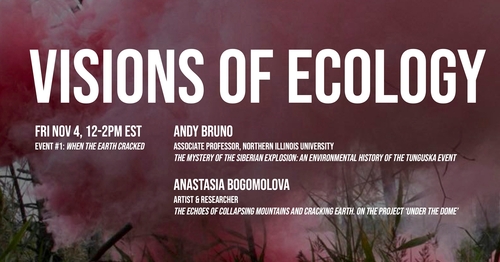
Visions of Ecology is a year-long series on art and the environment in Eastern Europe and Eurasia supported by the Russian, East European, and Eurasian Studies (REEES) program at the MacMillan Center for International and Area Studies at Yale University. The series is convened by Molly Brunson, Associate Professor in Slavic Languages and Literatures and History of Art, who also serves as Faculty Director of REEES. The series is co-organized by Barbora Bartunkova, PhD Candidate in the History of Art, and Elena Adasheva-Klein, PhD Candidate in Sociocultural Anthropology.
The series opened on November 4, 2022, with presentations by Andy Bruno and Anastasia Bogomolova. Andy Bruno is an environmental historian of Russia and the Soviet Union with an interest in many aspects of human interactions with the natural world. He works as an Associate Professor in the Department of History and Faculty Associate in Environmental Studies at Northern Illinois University and is the author of The Nature of Soviet Power: An Arctic Environmental History (Cambridge University Press, 2016) and Tunguska: A Siberian Mystery and Its Environmental Legacy (Cambridge University Press, 2022). Anastasia Bogomolova is an artist and researcher working with performative practices. In their projects, Anastasia turns to the imitation of everyday rituals and studies mimicry as a theme, method, and visual language. Anastasia’s work engages with the flexible nature of memory and oblivion and the depiction of traces. Anastasia is a winner of the Present Continuous 2021, a joint initiative of the V-A-C Foundation and the Museum of Contemporary Art in Antwerp (M HKA); the Garage Museum’s Grant Program (2017, 2018); the Credit Suisse and Cosmoscow Art Prize for Young Artists (2016); and has participated in artist-in-residence programs in Switzerland, Sweden, and Russia. Anastasia lives and works in the city of Yekaterinburg in the Urals, Russia.
Andy Bruno presented a talk titled, “The Mystery of the Siberian Explosion: An Environmental History of the Tunguska Event.” In 1908 the Tunguska explosion in Siberia knocked down an area of forest larger than London. Most scientists believe that a fragment of an asteroid or a comet caused the blast, but neither a crater nor unmistakable remnants of a meteorite have ever been found. Over the last century, the mysterious nature of the event has prompted a wide array of speculation and investigation, including from science fiction writers and voluntary researchers. Some have even explained Tunguska as a nuclear explosion triggered by aliens. Bruno’s presentation recounted this intriguing history of the Tunguska event and the investigations into it. Foregrounding the significance of mystery in environmental history, Bruno showed how efforts to understand the explosion shaped the treatment of the landscape, how uncertainty allowed alternative forms of knowledge to enter scientific conversations, and how cosmic disasters have influenced the past and might affect the future.
Anastasia Bogomolova spoke about their artistic practice in the talk titled, “‘The echoes of collapsing mountains and cracking earth’: On the project ‘Under the Dome.’” The falling of the meteorite Chelyabinsk on February 15, 2013 was called by astronomers “a historical event.” It was the largest meteorite after the Tunguska phenomenon and, undoubtedly, the most documented. Starting with this event, Bogomolova researched other sites of fallen meteorites in the Urals and converted their illusive traces into catastrophic visual and sound images. In their talk, Bogomolova unveiled their artistic approach, demonstrating how the obsession with finding meteorites approximated a pilgrimage to sacred places.
During the discussion period, Bruno and Bogomolova addressed the various types of archives and material culture they work with, the importance of experiential engagement with sites and places, and the role of imagination in constructing their narratives. The speakers reflected upon the role that mass media played in transforming the cosmic disasters into broader cultural phenomena in both 1908 and 2013. Bruno and Bogomolova also considered the religious and spiritual connotations, especially in the evocation of mystery and pilgrimage, of the Tunguska explosion and meteorites in the Urals.
Watch video recording on the Yale European Studies Council YouTube chanel.

